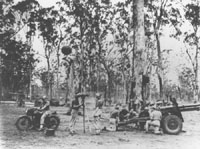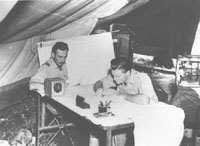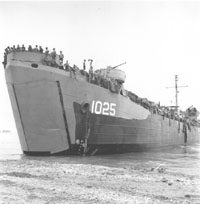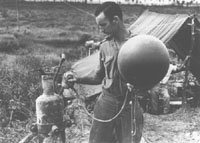


RAAF Meteorological Service
Foreword
Introduction
Chapter 1: The Weather Factor in Warfare
Chapter 2: Establishing and Developing the RAAF Directorate of Met. Services (D.Met.S)
Chapter 3: Recruiting and Training of Personnel
Chapter 4: Meteorology in Aviation
Chapter 5: The Met. Retreating
Chapter 6: The Met. Advancing
Chapter 7: The Met With the Army and the Navy
With the Army
With The Navy
Chapter 8: Divisional Offices of the Bureau of Meteorology During the War
Chapter 9: Research and Instrumental Development
Chapter 10: The End, Aftermath, and Beyond
Appendix 1
Appendix 2
Appendix 3
Appendix 4
References
Index
Search
Help
Contact us

With the Army (continued)
Professor D. Mellor stated:'When it became necessary to bring a barrage down to within fifty or eighty yards of our own troops, meteorologists were hard put to it to keep up a sufficiently rapid flow of observations. Firing in the jungle at night to prevent infiltration by the Japanese was often greatly assisted by a knowledge of wind velocity. It was possible for the artillery to direct its fire to a particular zone without preliminary ranging shots, and so, to surprise the enemy.'
'For long-range firing, the ballistic correction was sometimes astonishingly high. For example, in March 1945, a detachment from No. 3 MMF in action with the 2/2nd Australian Field Regiment at Matapu, west of Aitape, calculated a range correction of 1,025 yards for a battery firing a supercharge from the Anumb River to the outer defence of But, with our own troops disposed less than 300 yards from the area. The correction was something of a record, and its application in the circumstances indicated great confidence in the work of the meteorologists.'[82]
A somewhat similar dramatic incident occurred when I was in charge of a detachment of No. 1 MMF at No. 1 Australian Corps, Headquarters on the Atherton Tableland, Queensland, during 1944. The AIF 6th and 9th Divisions were there preparing for the forthcoming campaign in the Aitape-Wewak-Nadzab area of northern New Guinea. On 23 November 1944 an artillery battery of 6-inch howitzers was conducting a shoot for officer training purposes. The scene was the wilderness of the Walsh River area. The Colonel of the regiment involved, and a group of subordinate officers, were at an observation post there about nine miles from the gun emplacements. The Colonel had ordered me to stand by with the 'meteor' ready to be used when he directed.




The target was an outcrop of granitic rocks some distance from the observation post. The firing began with the first salvo landing short. The second and third salvos were shorter still. The CO then turned to me and said, 'May we have the meteor please'. I handed over the ballistic figures written on a form and a Captain telephoned them back to the gunpits with the direction that the corrections be applied. We waited—I, with bated breath; the others with amused interest at my being on the spot. The salvo tore the air, whistled, screamed and hit—smack on the rocks!
'There you are gentlemen!' beamed the Old Man. 'Note the effect of ballistic winds and temperature'.
 |
Bureau of Meteorology |  |
© Online Edition Australian Science and Technology Heritage Centre and Bureau of Meteorology 2001
Published by Australian Science and Technology Heritage Centre, using the Web Academic Resource Publisher
http://www.austehc.unimelb.edu.au/fam/0298.html